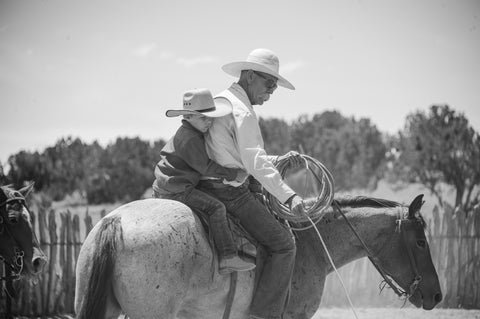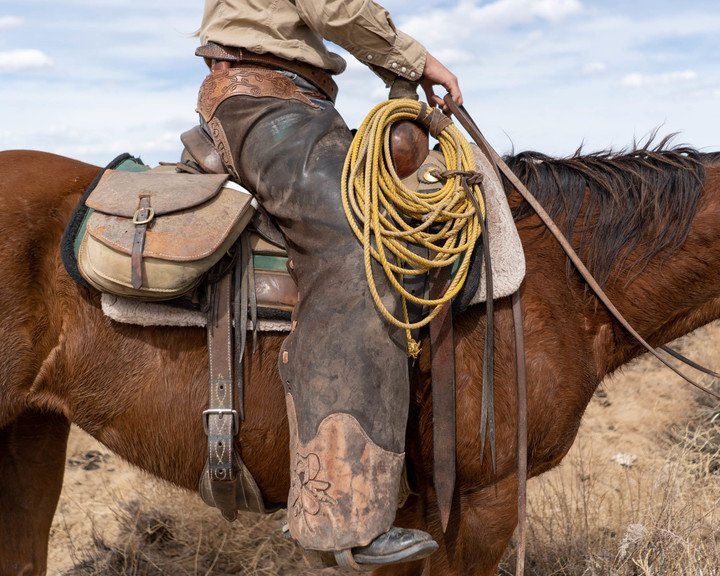Learning the Craft of Chap-Making
A ranger’s kit functions as a shadow limb. It requires a keen physical awareness on the part of the ranger to know which pocket holds the ammo and which pouch holds the flare. The specificity of equipment and placement is akin to the gear of a cowboy: choosing the right rope for the given terrain or the appropriate bridle set-up for a certain horse. Drawing parallels between these worlds energized Mike and informed his chap designs. He’s branched out to a variety of leather projects, from a medicine bottle pouch – a doctoring toolkit which attaches to his saddle just behind the cantle (with stitches, a prolapse kit, needles, paint, etc.) – and other pieces of tack, like headstalls and belts. But it’s the chaps that are his “number one thing,” the piece of gear he returns to again and again.
A Big Window into a Historic Colorado Home
When you step through the front door of the Big House, what strikes you are the windows. Standing 14 feet tall and 20 feet wide, they frame the west side of the living room, which looks out into the garden and hayfields beyond. The sun filters in and illuminates soft white stucco walls, saltillo tiles, and wooden countertops. There are vintage black and white photos of brandings, portraits of family members in ten gallon hats, and still life paintings by local artists. In the billiards room, a lofty space just beyond the kitchen, the reverent head of Acapulco, the lead steer of the Frost Livestock Company from 1958 to 1975, is now perched above the fireplace in retirement. As you continue through the house, silhouetted by the light of the prairie, it hits you: this is a living cowboy museum, a sweeping history spanning generations of Colorado’s ranching families. Lucidity is what Wallace Frost, the renowned American architect, was after, when he designed and built the Big House nearly seventy-five years ago.
Reading the Rocks
To explore this section of Wyoming is to delight in its contradictions: red clay hills anchored by sandstone, wildflowers sprouting out of black rock. These observations create a shared history that can only be found in stillness. As you ride through these distinct layers, you begin to picture the animals – antelope, horses, dinosaurs – and the landscapes – oceans, deserts, forests – that once existed. The parallels between the years appear like brush strokes in the mind, vivid yet fleeting.
Angels of Grass
This past September, we drove through the Sandhills of Nebraska for the first time. Starting in Ogallala, one of the original cattle trading posts, we meandered our way along back roads, to Valentine, a small town straddling two time zones in the northwest part of the state. In the span of about four hours only one car passed us and a steam engine train carrying coal chugged off in the distance. The hills, which were lush and green from a particularly wet summer, looked as if they would spill over the pavement and into my lap. As I gazed out the car window, I was reminded of the first time I’d driven through the Chico Basin Ranch gate four years ago, and seen grass in every direction. Jim Harrison says the Sandhills “remind you of a place we like to think we used to be, and even of a place we’d like to live in now.” These contradictory emotions, of reverence and yet, nothingness, swelled up inside me, and the hills formed a melody that lingers in my mind.
The Boss of the Plains Still Reigns: The History of the Cowboy Hat
It was the spring of 1849 and John B. Stetson was on a hunting trip near Pikes Peak, just outside Colorado Springs (about 45 minutes from Chico Basin Ranch), when he came up with the original design of what is now considered the classic “cowboy hat.” Stetson, in an effort to impress his comrades, collected beaver pelts and, over the course of several weeks, made himself an exceptionally large hat. The basic construction of the hat consisted of a wide, flat brim, and tall, open crown; the wider brim provided more shade and, in harsh wind and rain, the taller crown could be pushed down farther on the head and secured. John was teased by his friends for wearing such a ridiculous hat until a stranger rode up on his horse and asked to buy it off his head for a five dollar silver coin. Stetson obliged and off went the stranger in the first American cowboy hat. (Photo by Brennan Cira)
Herding Cultures from Around the World
Today, many herders continue to graze and manage their animals over varying terrain, on both public and private land, following the natural migration patterns of their herds. In an effort to underscore the importance of this vanishing way of life in the context of globalization and development, we wanted to share the stories of these indigenous groups that continue to graze their animals using traditional methods. For many herders (also referred to as “nomadic pastoralists”), essential animal habitat is threatened by corporations and governments seeking development opportunities. Often, their food, dress, and materials come directly from the animals they work with each day. It is our hope that these communities inspire you as much as they inspire us to continue to live with the land and fight to protect it.
Life in the Saddle
Last Wednesday we moved a group of pregnant heifers closer to headquarters in preparation for calving season. We arrived at the corrals before dawn and began to saddle our horses. The toss of the blanket, the swing of the saddle, the unbuckling of the cinch on the offside: this ritual, which lasts only a few minutes, is a chance to collect your thoughts and prepare for the day ahead. (Photo by Alice Wilkinson)
Sharp Enough To Change Your Mind
Have you ever been handed a knife that glides through a tomato so seamlessly it changed the way you approach cooking? That’s what twenty year-old Max Wenerstrom, who comes from a family of cooks, hopes to do with the Japanese-style forged knives he makes on his family’s farm in Ohio.
Knives should make any job; hunting, ranching, cooking, easier. As Max says, “a good knife is going to make your experience, whatever it is you do, more enjoyable”. (photo by Claudia Elise)
The Cottonwood
Willa Cather lived most of her life in the sandhills of Nebraska and considered the cottonwood tree to be “the most beautiful tree on the plains”. That’s probably because it was the only tree she saw, but still, it’s a lovely claim. Cather is not the only writer who has marveled at the cottonwood’s beauty and tenacity. Walt Whitman pointed to its practical use in his seminal Song of Myself, writing of travelers seeking refuge who “make fast towards dusk near the cotton-wood trees.” It’s a writer’s tree with a rich history and an even richer ecological importance. (photo by Robert Adams)
Tying the Knot between Cowboys and Sailors
Most people don’t think twice when tying their shoes or their tie. But the knot, defined as as a “complication in cordage” or “the fastening made by tying a piece of string, rope, or something similar,” is a deceivingly simple, omnipresent concept at work in nearly every facet of our lives--from the wire suspension in bridges to modern art to the pretzel on our plate. Most of us only know a few (the square knot or maybe the bowline), but there are thousands upon thousands of knots in existence, each with their own backstory and specific purpose. Take, for instance, the “granny knot,” frequently used by surgeons as a binding knot. From the “sheepshank” to the “wall and crown,” the name of the knot is often more beguiling than the knot itself. (Photo by Alice Wilkinson)









